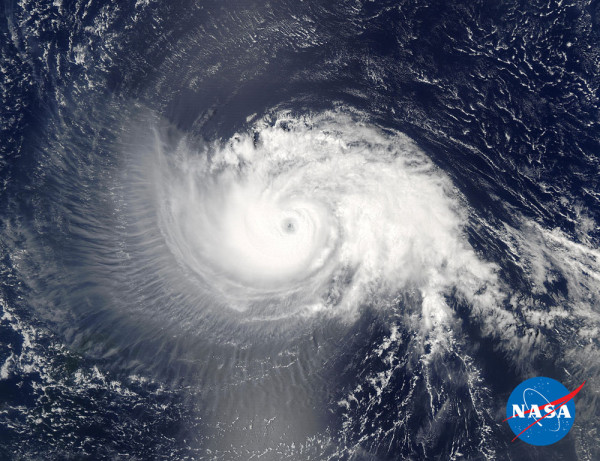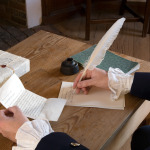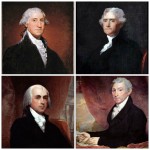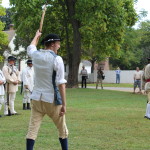 June 1 marks the official beginning of the Atlantic hurricane season. As Virginians, we’re well aware of the increased risk for high winds, coastal flooding, and tornadoes over the next few months. These were the same threats in the 18th century. The difference is that colonists didn’t have weather technology to warn them of the impending danger.
June 1 marks the official beginning of the Atlantic hurricane season. As Virginians, we’re well aware of the increased risk for high winds, coastal flooding, and tornadoes over the next few months. These were the same threats in the 18th century. The difference is that colonists didn’t have weather technology to warn them of the impending danger.
According to the National Weather Service, the government didn’t keep official weather records for the Hampton Roads area until 1871. Any knowledge of storms from before that period comes from ship logs, newspapers, and diary entries. Thanks to those documents, we know there were several hurricanes that blew across the Peninsula in the 1700s. The storms caused deadly tidal flooding and swept many ships and sailors out to sea or sent them crashing into the shore. There were three storms in particular that had significant impact on Virginia during the mid and late 18th century. One hit at the beginning of the Revolution, another toward the end, and one after General George Washington had returned home and was considering a run as president of the newly free United States of America.
The Independence Hurricane
It was September of 1775 when a massive hurricane barreled up the east coast. Several colonial capitals, including Williamsburg, were directly in its path. The gale force winds and a 30-foot storm surge would hit Virginia just a couple months after the start of the Revolution. Colonists had to put aside one fight for another—and without radar and warnings, this was a battle they never saw coming. The storm wiped out many British ships (mainly from England and Ireland) and left 4,000 people dead in the U.S. and Canada. According to the Virginia Department of Emergency Management (VDEM), 163 of those victims were from the Commonwealth and North Carolina.
On September 9, The Virginia Gazette detailed some of the devastation by writing, “The shocking accounts of damage done by the rains last week are numerous: Most of the mill-dams are broke, the corn laid almost level with the ground, and fodder destroyed; many ships and other vessels drove ashore and damaged, at Norfolk, Hampton, and York.”
The following week, another mention of the hurricane in the Gazette: “Many people, we learn, have lost their lives in the late storm. The vessel we mentioned…. as being cast away and destroyed, together with the most of her crew, belonged to Mr. Roberts, of Portsmouth. Lord Dunmore, it seems fared but poorly in this hurricane, as, by some accident or other, occasioned by the confusion in which sailors were, his lordship fell overboard, and was severely ducked. But according to the old saying, those who are born to be hanged will never be DROWNED.”

Local historian and author Tony Williams wrote a book titled “Hurricane of Independence: The Untold Story of the Deadly Storm at the Deciding Moment of the American Revolution” and traced the storm’s path of destruction through the colonies. Mark your calendars for August 21. That’s when Williams is scheduled to speak at the Hennage Auditorium inside our Art Museums about the historical significance this major hurricane.
The Great Hurricane of 1780
Still, that destruction was nothing compared to The Great Hurricane of 1780 which would go down in the history books as the deadliest hurricane of all time. More than 20,000 people lost their lives when the storm blasted its way through the Caribbean near Martinique and Barbado. It was the middle of the Revolution and an unusually high number of British and French fleets were patrolling the seas, hoping to gain control of the New World’s Atlantic coast. Both sides suffered major losses that would eventually influence military strategics for the remainder of the American Revolution. Several vessels capsized and thousands of sailors and crew members drowned as the angry sea raged around them for days.
George Washington’s Hurricane
Not only did the Commander-in-Chief of the Continental Army end up with a snowstorm named after him, he also had a hurricane awarded his namesake. The name stems from the path of the storm’s destruction as well as the fact that most of what we know about it came from Washington’s journals. The center of the hurricane passed right over his Mount Vernon estate on July 23-24, 1788 where he’d returned after winning the War of Independence. He wrote of the storm, “In aword it was violent and severe—more so than has happened for many years.” Washington also wrote about extensive crop damage and several ships that ran aground including a small ship that had been gifted to him. The “Federalist” which he’d owned for only six weeks sank during the chaos.
And even before the hurricane made its way up the Potomac, it wreaked havoc on those living along the Chesapeake Bay. According to a Philadelphia newspaper account, when the storm hit the tidewater area, it “continued for 9 hours—wind at start from NE—at 0030 [hours] it suddenly shifted to S and blew a perfect hurricane—tearing up large trees by the roots, removing houses, throwing down chimneys, fences, etc., and laying the greatest part of the corn level… Only two ships in Hampton Roads survived the gale.”
Have you ever ridden out a major hurricane along the East Coast? Share your stories in the comments below.



Louise C Gaskins says
As a Virginia resident for many years, especially the Tidewater area, my family rode out the storms.northeasters
were the worst. My grandparents, nor my great aunts, ever talked about storms.My grandfather’s family
lived in Washington, DC.Thanks for your post.I do genealogy for my families, nice addition, to add.
Thank you for this essay!
During the War of 1812, was it a hurricane or a tornado that ripped through Washington DC? From what I remember, scholars speculate that the sudden storm helped prevent the White House from being burnt to the ground and from the city being taken by the British. The storm dumped hail and buckets of rain, and had vicious winds. The Republic saw the storm as a sign from Providence, that they would be victorious by the help of God, sanctifying the new country. Is there any writing on the “divine nature” of these Revolutionary storms from either side?
Thank you for this great article. I love meteorology and history and this article taught me both. So many people perished in those hurricanes and that makes me sad. When I was 15 my parents took us on an extended camping trip to Myrtle Beach, South Carolina. A hurricane had just moved up the coast and we were there in the torrential downpours of rain - for 2 days. Needless to say - our camper was waterlogged, but after the storm moved out to sea - the weather was perfect!!
Please keep finding great historical article/facts to share with us!!
Thank you, Jan! I’m glad you enjoyed reading it! And I know what you mean about the weather being beautiful right after a hurricane. I covered many storms in VA and NC as a news producer and the live shots the day after they had moved through, were almost eerily beautiful-especially after broadcasting so much doom, gloom, and destruction for days.